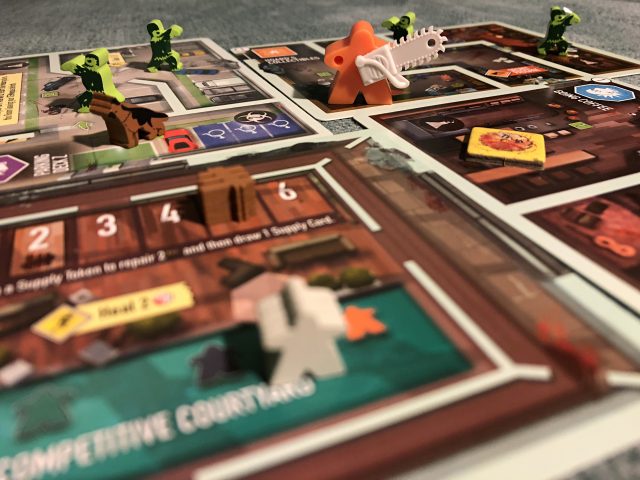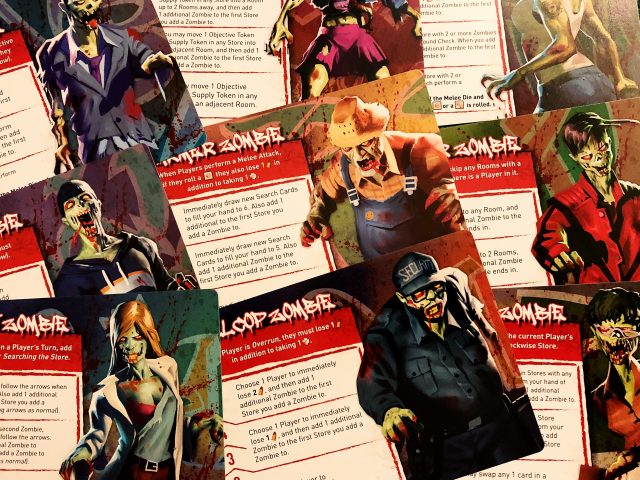Well, as I mentioned back in August, Gamelyn Games delivered on their promise to get their latest game out to backers before the fall. It’s the newest game in their Tiny Epic series, Tiny Epic Zombies. Although copies have yet to hit stores, I received my Kickstarter copy a couple of weeks ago and wanted to fill you in. Is it a true TARDIS game? Read on.
The Kickstarter campaign promised multiple modes of play: solo, full co-op, co-op vs. Zombie player, competitive vs Zombie player, and full competitive, and the game includes rules for all five modes. The setting for Tiny Epic Zombies (TEZ hereinafter) is your local mall, represented by larger cards representing the inner Courtyard where you’ll set up your Barricade as well as 16 possible stores (on 8 double-sided cards) each with its own activatable power and kind of swag. It’s all about options.
 I feel like Scott Almes works backwards from theme to mechanics when he designs his Tiny Epic games. He starts by asking himself what thematic elements need to be in the game, then figures out how to have them appear in the game mechanically. He tends to avoid obvious choices where possible. For instance, in the flagship of the series, Tiny Epic Kingdoms, he had players draft actions from a common menu instead of just letting everyone do what they want. In Tiny Epic Galaxies players had to choose between bopping down to a planet for one-time benefits and settling in for a longer haul by exploring and possibly getting the planet all to themselves.
I feel like Scott Almes works backwards from theme to mechanics when he designs his Tiny Epic games. He starts by asking himself what thematic elements need to be in the game, then figures out how to have them appear in the game mechanically. He tends to avoid obvious choices where possible. For instance, in the flagship of the series, Tiny Epic Kingdoms, he had players draft actions from a common menu instead of just letting everyone do what they want. In Tiny Epic Galaxies players had to choose between bopping down to a planet for one-time benefits and settling in for a longer haul by exploring and possibly getting the planet all to themselves.
For TEZ Almes knew he wanted to go with a tower-defence situation set in a mall, with a ton of stereotypical characters racing around hacking and shooting at zombies with a large variety of weaponry. But tower defence alone would not give enough replayability (which is one reason Castle Panic and all its descendents eventually pale despite the excellent gameplay). He must have realized at some point that imposing sidequests on the players would not only ratchet up difficulty but also drastically increase replayability. These Objectives reek with theme, play quite straightforwardly, and really do make every play of the game different. The problem is that the Objectives vary dramatically in difficulty, so that if you pick randomly and/or badly, you are, as they say, doomed. The same goes for the characters themselves. At different player counts, and in different modes (see below), some characters are easier/better than others, and there is no handicapping system. So beware zombie slayer(s).
Each Human player takes a turn moving, attacking, and searching, after which the Zombie player or AI (depending on mode) checks for “noise”, allowing them to use one of their Horde powers, spawns new undead–possibly spilling into the Courtyard to damage the Barricade, and finally distributes new Search cards. One nice twist is that the Humans MUST keep moving; they cannot turtle up somewhere and lay down a deadly line of fire. They won’t want to, because completing the Objectives always involves scurrying around the map anyway.
 The components are typically high-quality, as one would expect from Gamelyn. The zombie meeples are painted, and the player meeples have holes in them a la Tiny Epic Quest so you can kit them out with the weapons’n’stuff you find throughout the mall. The game art is cartoony and only slightly gory–suitable for kids 12 and up, surely.
The components are typically high-quality, as one would expect from Gamelyn. The zombie meeples are painted, and the player meeples have holes in them a la Tiny Epic Quest so you can kit them out with the weapons’n’stuff you find throughout the mall. The game art is cartoony and only slightly gory–suitable for kids 12 and up, surely.
Some people have complained about the TEZ rules. Personally I found them fine, basically, needing only a few clarifications for poorly-defined concepts (is the Courtyard the entire middle card? Or just the middle area of the card?). Others have poured on the questions, so the Rules forum on BGG is alarmingly large, but Gamelyn has gamely answered all politely-posed questions and there is a perfectly serviceable FAQ here.
Altogether TEZ does a very good job of covering its genre-territory. Purists will probably prefer Dawn of the Zeds, but I think TEZ is up there with it, and has the benefit of its small box and footprint. Ignore the whining about the rules and get into the spirit.
Comments
No comments yet! Be the first!